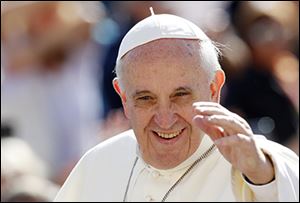
New sacrament
Pope Francis’ style and priorities offer Catholics a big change from his tradition-minded predecessors
9/29/2013
Pope Francis
Pope Francis’ style is a radical change — and in the Catholic Church, style matters. Roman Catholicism is a sacramental religion whose symbols speak with power to the faithful and beyond.
In recent interviews with Jesuit journals that made international headlines, the Jesuit Pope said the church must move beyond its emphases on abortion, gay marriage, and birth control to deal with concerns of everyday people. It must “heal wounds and warm the hearts of the faithful,” he said. “I see the church as a field hospital after battle.”
This kind of talk “feels like gospel,” a priest said. “It feels like Jesus.”
In admonishing the church not to allow its bans on same-sex marriage, abortion, and contraception to dominate its teachings, Pope Francis has largely replaced the finger-wagging style of his predecessors. His effect on the larger culture is remarkable: One priest said the Pope couldn’t have hired a public relations firm and gotten this much positive publicity in such a short time.
The Pope has washed the feet of a Muslim woman during Holy Week, chatted up reporters on a plane, shunned the regal trappings of the papacy, called himself a sinner, talked about God’s love of gays, avoided condemnation, and openly called for a new, more nurturing, church. He has even called people on the telephone.
For Catholics of a certain age, Pope Francis is bringing back the exciting days of Pope John XXIII and the Vatican Council of 1962-65, which wrenched the church out of the Middle Ages. Some theologians call the council the most important event in church history since the Protestant Reformation.
The reforms of Vatican II threw open the windows of the 2,000-year-old institution, with new emphasis on sending Christ’s message into the world. The Mass was changed to the language of the people from Latin. The altar was turned around to face the congregation.
The church reached out to other faiths. New emphasis was placed on Scripture, dialogue, laity, and the role of bishops.
Popes John Paul II and Benedict XVI, Pope Francis’ immediate predecessors, began to pull back from those reforms. John Paul consolidated power in the Vatican. Benedict had a vision of a church that was smaller, purer, and more orthodox.
Rome and the hierarchy were, in the eyes of many, slow to deal with the money and sex-abuse scandals that angered the laity, erased the culture of deference toward clerics, and undermined the authority of the hierarchy.
Those who expect Pope Francis to change church doctrine in any substantive way may be disappointed. Already he faces pressure from conservatives.
But his style is a radical change, and that matters. For decades, Catholic children memorized this definition of a sacrament in the Baltimore Catechism: “A sacrament is an outward sign instituted by Christ to give grace.”
Pope Francis’ admirers say he is empowered by the Holy Spirit in this Pentecostal moment. He is becoming a new sacrament in his own way.